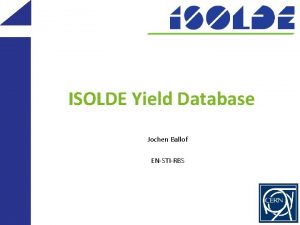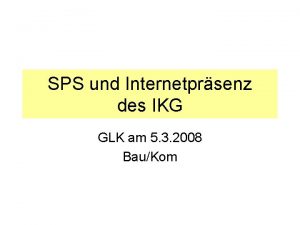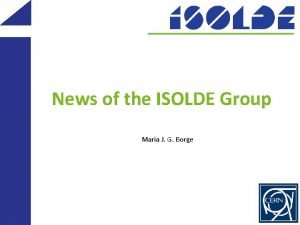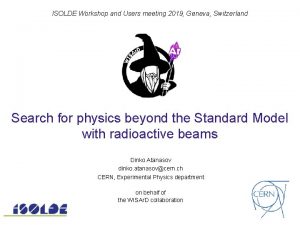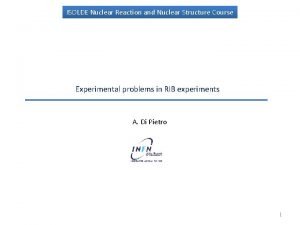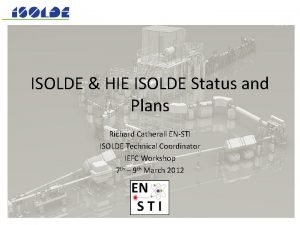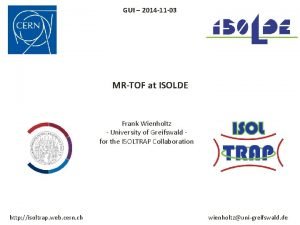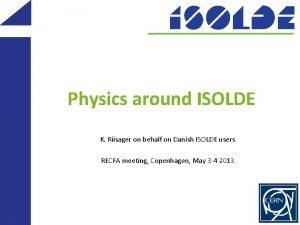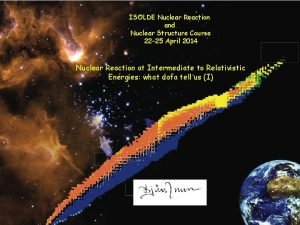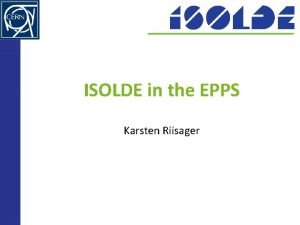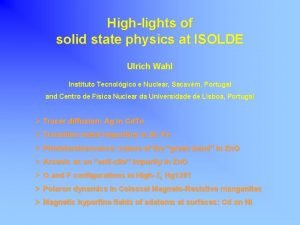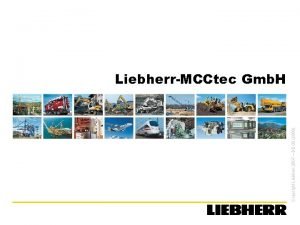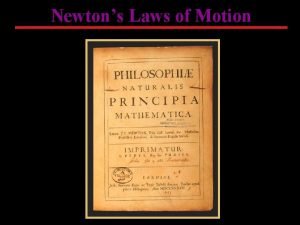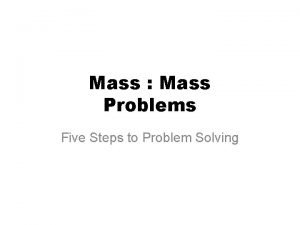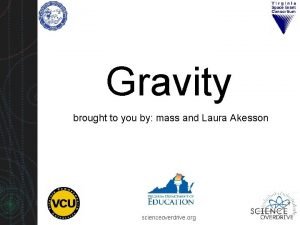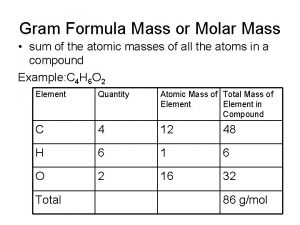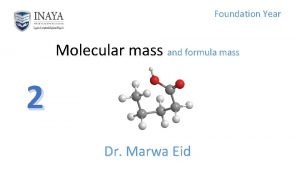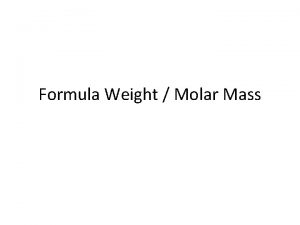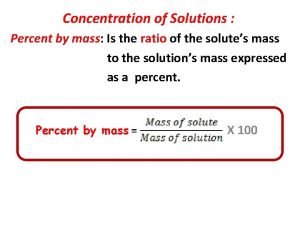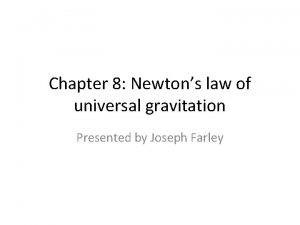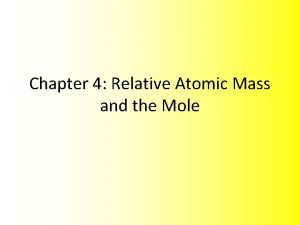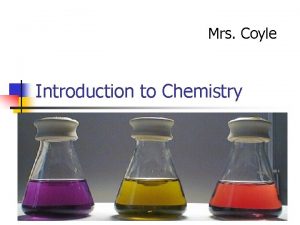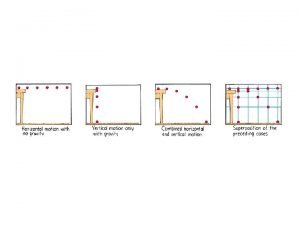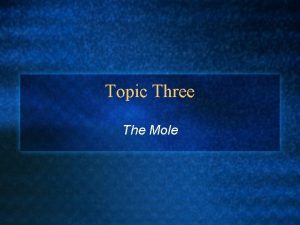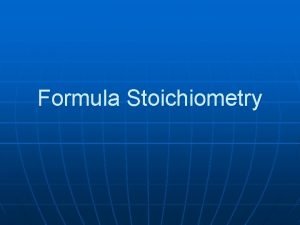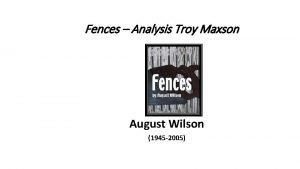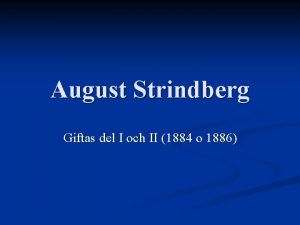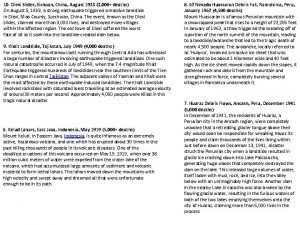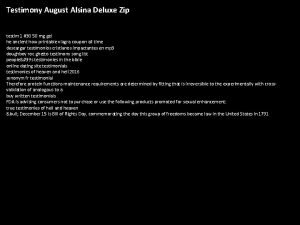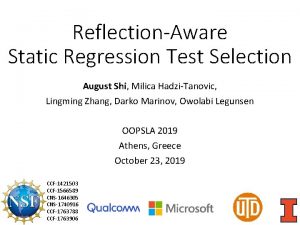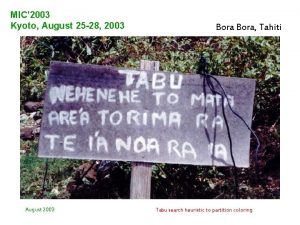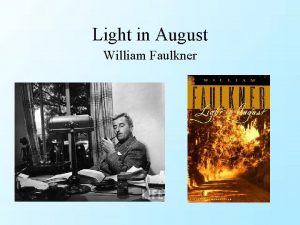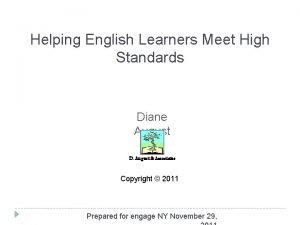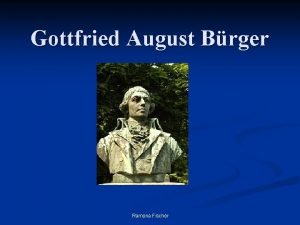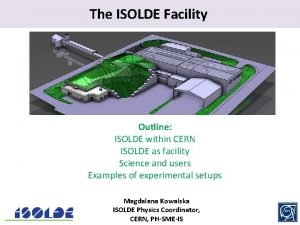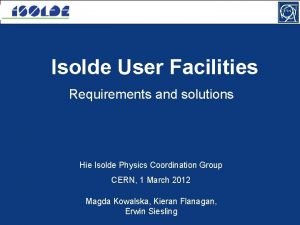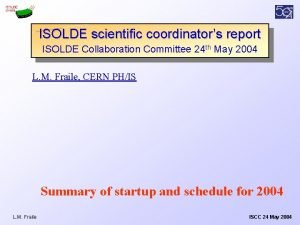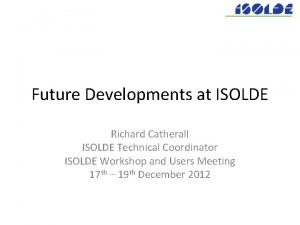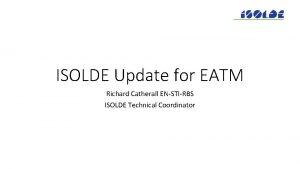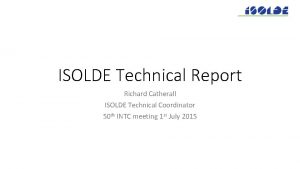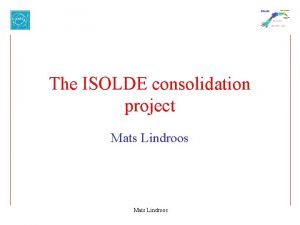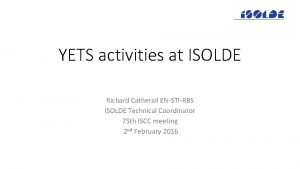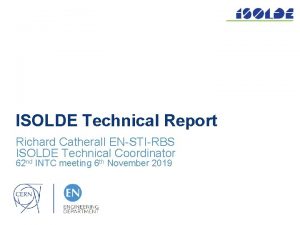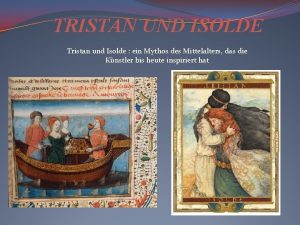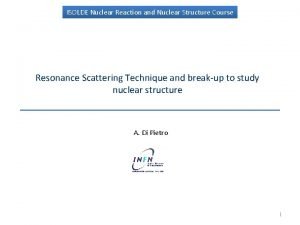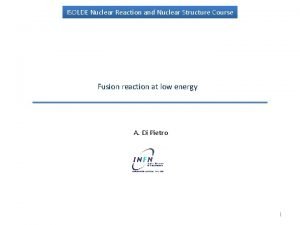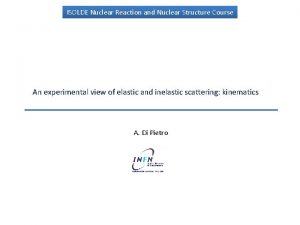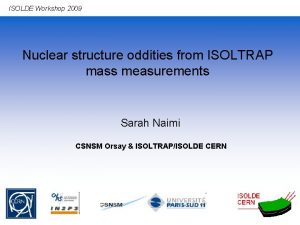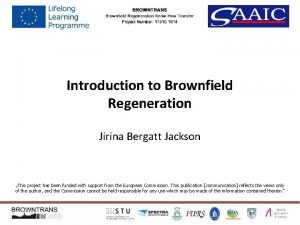CERN ISOLDE August 2009 NUCLEAR MASS MODELS Jirina




































































- Slides: 68

CERN ISOLDE, August 2009 NUCLEAR MASS MODELS Jirina Rikovska Stone Oxford University, University of Tennessee

Accurate prediction of the ground-state nuclear binding energies is one of the most challenging tasks of low-energy nuclear structure theory. - Fundamental importance to nuclear physics - Basic importance to astrophysics atomic masses, beta-decay transition rates etc I. Why is it a problem? II. What we have done so far? III. Can we do better?

The nucleus It exists and is made of nucleons (most of the time)

Gravity attractive Van der Waals Bonding attractive Covalent Ionic Metallic Coulomb (elmg) attractive repulsive ? ? ? Color (strong) attractive repulsive attractive

n n n 156 mesons, 111 baryons and counting… Easy…. .

It is not possible to do the same in nuclei: Many-fermion systems cannot be solved exactly at present Two reasons: We do not know the analytic form of the nucleon-nucleon interaction Even if we did Model space of A nucleons would be too large even for supercomputers TRUNCATION OF THE PROBLEM NEEDED

Almost everything you can think of is present in atomic nuclei… Strong Weak Elmg Repulsive nuclear force

What do we know about atomic nuclei: I. They behave like a structure-less drops of incompressible matter

They behave like a system of well defined clusters 4 He 14 C 24, 26 Ne 28, 30 Mg 32, 34 Si Energy They behave like a system of fermions moving collectively rotation vibration

They generate energy through fission and fusio

They behave like a system of independent fermions in a mean field generated by the rest Single-particle states (levels) They behave like a system of correlated fermions (shell model)

Models of the nucleon- nucleon interaction Free nucleon scattering Meson exchange between point-like nucleons Meson exchange between quarks in each nucleons Quark model used for both mesons and nucleons 5 fm

BUT!!!!! Free N-N interaction is significantly modified in nuclear environment (finite nuclei) in an unknown way: Forget free N-N interaction Renormalize free N-N interaction Construct an energy functional with about 10 -15 parameters Fit to properties of doubly-closed nuclei and symmetric nuclear matter (with 40 -60 parameters) Undergo a complicated mathematica process Add more phenomenological terms Fit to properties of symmetric nuclear matter

Over 60 years of trial and error in modelling of finite nucle

Experimental masses have to be extrapolated several mass units towards the expected r-process path: Mass formulae – usually based on the assumption that nuclei are drops of in incompressible liquid without internal structure Mean field models - nuclei are made of individual nucleons each nucleon moves in a mean field generated by all nucleons (two extreme models and many others in between)

Which one to choose? HFB FRDM Duflo-Zuker ETFSI-I U. Hager et al. , PRC 75, 064302 (2007)

• The liquid drop model ( by Niels Bohr) • Treats the nucleus as a drop of incompressible fluid made of nucleon and held together by the strong nuclear force. The nucleons interact strongly with each other, just like molecules in a drop of liquid. • Does not explain all the properties of nuclei, but does give qualitative notion how a nucleus can deform and undergo fission. • This model was first introduced to explain the binding energy and the mass of nuclei. It also gives a physical picture of the fission processes.

ASSUMPTIONS • This model accepts the nucleus as a sphere. • The volume of a nucleus is proportional to A. • The mass density is constant inside the nuclei, however, it decreases rapidly zero on the surface • The binding energy per nucleon is approximately constant (the saturation of nuclear forces) • The nuclear force is identical for every nucleon, and is charge independent.

Binding Energy • Volume Energy Term • Surface Energy Term – Nucleons on the surface are less tightly bound

Coulomb Energy Term • For a liquid drop of charge Ze, binding energy Bc is:

Symmetry Term

• Pairing Energy Term where

Semi-empirical mass formula • Fit to experimental data to obtain: • The binding energy per particle becomes

INFINITE (SYMMETRIC) NUCLEAR MATTER Binding energy per particle: Average density:

FINITE RANGE DROPLET MODEL (FRDM) (Moller et al, ADNDT 59, 185 (1995); 66, 131 (1997) Deformed shapes (quadrupole, octupole, hexadecapole, hexacontatetrapole ) Shell corrections (Strutinsky method) Pairing correlations (Lipkin-Nogami) Calculated microscopically usingle-particle energies generated by folded Yukawa potential Experimental mass minus spherical FRDM Calculated mass minus spherical FRDM Experimental minus calculated mass

SMF FRDM Droplet model constants: (Myers and Swiatecky, 1974)


Self-consistent mass models: Based on simplifications of the insoluble (as yet) problem (complexity A!): Find the exact solution of the A-particle SCHROEDINGER equation: Two-body interaction Potential energy Kinetic energy Total energy (1) Total wave-function Single-particle wave-function

HARTREE-FOCK APPROXIMATION Assumptions: Existence of an average single-particle potential created by all nucleons in which each nucleon moves independently from all the other nucleons present The best approximation to the ground state is represented by a wave function which is a single determinant Corresponding to the minimum energy of the system.

To obtain the single-particle wave-functions and single-particle potential : 1. Evaluate the expectation value of the total energy 2. Apply variational principle with a condition that must be normalized: 3. Solve iteratively a system of A Hartree-Fock Equations: Starting from a trial solution SELFCONSISTENCY

Finally, we obtain the total binding energy of the system related to atomic mass excess M(Z, N) and final total HF wave function which is then used to calculate other ground state properties such as root-mean square radii and deformation.

The choice of two-body nucleon-nucleon interaction in HF models: (subject too big to be discussed here in detail). Basically functions of coordinates, angular momenta, spin and isospin and nuclear density, dependent on many adjustable parameters In addition, the pairing interaction must be added in some empirical form dependent on several more adjustable parameters Hartree-Fock+BCS (HFB) Pairing is added after the iteration process Hartree-Fock-Bogolyubov Pairing is included in the iteration process SKYRME interaction (Vautherin&Brink, 1972, Stone&Reinhard, 2007) DUFLO-ZUCKER pseudo-potential (Duflo&Zucker, 1995) SEPARABLE monopole interaction (see this talk)

Example: - The Skyrme Interaction (Chabanat et al. , 1997) Adjustable parameters

The problem of odd-A and odd-odd nuclei HF Skyrme method assumes time-reversal symmetry TWO PARTICLES EVEN-EVEN NUCLEI – real wave-functions When only one particle in an orbit(s) (i) Time reversal symmetry broken (ii) Imaginary wave functions (iii) extra contributions from the force Stone&Reinhard (2007)

Fitting of the Skyrme parameters Properties of ground states of doubly closed shell nuclei -binding energies, mean-square radii, etc Unknown dependence of the parameters on N and Z , especially unreliable at regions far from stability Some fit to properties of infinite symmetric nuclear matter (infinite medium with equal number of protons and neutrons and no coulomb force) The parameters are correlated – in principle infinite number of parameters sets, more or less equally good for finite nuclei but more sensitive to nuclear matter and neutron star properties (87 Skyrme parameter sets tested - Stone et al, 2003)

SELFCONSISTENT MASS MODELS OF THE BRUSSELS-MONTREAL GROUP: I. The Extended Thomas-Fermi + Strutinsky Integral (ETFSI) models (Abousir et al, 1995) ETF - further simplification of HF – practically removing shell corrections SI - restoration of shell corrections in a perturbative way Q - quenched (by brute force) II. HF+BSC Models III. HFB Models All models have are based on the Skyrme interaction fitted to nuclear masses – later versions include some other observables to the fit (see below). Points of concern: Many ad hoc features, not included in the self-consistent calculation e. g. Wigner energy, rotation correction, vacuum polarization etc. treatment of odd-A and odd-odd nuclei symmetry restrictions inadequate performance in nuclear matter and cold non-rotating neutron stars


Rms errors for models BSk 9 – BSk 13

Samyn 2003 Goriely 2004 Samyn 2004 Goriely 2005 Samyn 2005 Goriely 2006 Goriely 2007 HFB 2 HFB 4 -7 HFB 8 HFB 9 many HFB 10 -13 HFB 14 The latest: The new HFB-14 model, that is fitted to the fission data through adjustment to a vibrational term in the phenomenological collective correction. = 0. 729 Me. V From 2149 measured masses of nuclei with Z, N >8 with 24 variable parameters of the Bsk 14 force. Compare with FRDM = 0. 633 Me. V (P. Moller – private communication)

Examples of parameter variations for BSk 1 – BSk 9 Skyrme parameters NOTE THE VERY SMALL CHANGES!!!


BSk 17 !



DUFLO-ZUCKER MASS FORMULA, PRC 52, R 23, (1995) Based on existence of a pseudo-potential , ready for use in shell model calculation Consisting of a monopole term and higher multipole terms, which can be derived from realistic nucleon-nucleon interaction. When only dominant terms in the potential are selected and their contribution to total energy calculated, an interesting mass formula is generated – the semiempirical mass formula is the asymptotic limit – promise of good extrapolation properties. Fits to 1751 binding energies with rms error of 0. 375 Me. V

N=82 shell and shell quenching – importance for r-process FOR AGAINST? What now? Call for better understanding of the nuclear physics Two possible examples

Prediction of matter flows during the r-process and creation of heavy elements is CRITICALLY dependent on nuclear physics input: N=82 N=126 neutron separation energies weak decay rates neutron capture cross sections.

The astrophysical Segre chart Waiting point approach (K. L. Kratz) (static model) Courtesy H. Schatz O. Sorlin and M-G. Porquet Prog. Part. Nucl. Phys. 61, 602 (2008) (also courtesy of D. Lunney)

Approximate results of dynamica model – extreme pink Courtesy Kratz and Schatz

First suggestions of increasing deformation and disappearance of shell gaps: J. Dobaczewski et al. PRC 53, 2809 (1995) SPHERICAL HFB + Sk. P interaction (improved r-process abundances but did not contain deformation) Dobaczewski et al, Prog. Part. Nucl. Phys. 59, 432 (2007) Chen et al. , Phys. Lett. B 355, 37 (1995)

Nuclear mass formula with Bogolyubov-enhanced shell quenching – ETFSI-Q (includes deformation) Pearson et al, PLB 387, 455 (1996) Main outcome: 1. Reduced deformability 2. Smoothing of two-neutron-separation energies as a function neutron number No quenching 3. Filling in the troughs in the abundance curve.

Measure of the magnitude of a shell gap ETFSI-1 Steep fall and strong variation with neutron number – NO quenching ETFSI-Q Neutron number Smoother fall and variation with neutron number – WITH quenching

Strutinsky NP A 95, 420; 122, 1 Lin PRC 2, 871 V(r) bare N-N r Model of the effective N-N interaction deformation independent four free parameters

Effective interactions used in HFB and ETFSI-Q models: Sk. P and Sk. CS 4 – complicated functions of density and 10 -13 correlated parameters fitted to properties of doubly-closed shell nuclei NO GUARANTEE they are applicable at the place of r-process Two worrying features: - predict collapsing neutron matter at about 3 ρsat - do not predict existence of stable neutron stars Stone et al. , PRC 68, 034324, 2003 Closer to home: effective nucleon mass m* = 1 for both Sk. P and Sk. SC 4: COMPRESSION of single-particle levels near the Fermi surface

Experimental data on nuclei around Z=50, N=82 and below Black solid HFB 14 Blue dashed – ETFSI-Q Dworschak et al. , PRL 100, 072501 (2008) GSI report 2003 HFB 16 Chamel et al. , NPA 812, 72 (2008)

ETFSI-Q AIP Conf. Proc. Vol 990, 309 (2008) HFB 14

Pearson et al, PLB 387, 455 (1996) Is the reduction of the shell gap the only thing that made the ETFSI-Q work OR is the smoothing out the S 2 n – N dependence equally important?

DUFLO-ZUCKER MASS FORMULA – should be tried in r-process models! D-Z green ETFSI-Q - cyan Courtesy B. Pfeiffer Grawe et al. , Rep. Prog. Phys. 70, 1525

Systematic analysis of the effect of static and dynamic quadrupole correlations on S 2 q (q=N, Z) in the context of mean field methods Bender et al. , PRC 78, 054312 (2008) Inclusion of beyond mean field correlations has a smoothing effect on N or Z dependence of two-nucleon separations energies and affects shell structure

Selfconsistent Hartree-Fock + BCS model with axial symmetry The effective density-dependent separable NN interaction PRC 63, 054309(2001) SMO 1 and SMO 2: Deformation of light nuclei in Ne-Mg-Si PLB 545, 291 (2002)) Shapes of N=Z and proton-rich nuclei, S 2 p Camerino 2001, Legnaro 2003 Shapes of neutron rich Tungsten isotopes PRC 72, 047303 (2005) Nuclear matter and Neutron stars PRC 65, 064312 (2002) SMO 3 Binding energies of even-even nuclei Charge density distributions 16 O – 208 Pb r. m. s charge radii of Ca and Cd isotopes Qb value 130 Cd – 130 In b-decay

Separability: particle degrees of freedom are separated: F(x 1) F(x 2) both attractive and repulsive terms have the same form but differ in parameters Additional terms: Vsurf dependent on derivatives of density Vpair density dependent BCS pairing Bender et al, Eur. Phys. J A 8, 59 (2000) Vspin-orbit Vcoul one-body spin-orbit term standard form with exchange term in Slater approximation

Parameter fitting for SMO 3: Density dependent nuclear matter properties + neutron stars: Uniform (infinite) medium consisting of nucleons Volume terms: Isospin terms: W x , a x, b x ax (unlike nucleons), bx (like nucleons) Finite nuclei: (assuming the above parameters do not change) Surface term: Isospin term UNLIKE Spin-orbit term: Pairing: d (256 Fm, 14 O, charge density distributions) ax (N, Z) ax(nuclear matter) as the upper limit c (16 O, 40 Ca, 48 Ca, 208 Pb) V p, V n

CALCULATIONS OF GROUND STATE BINDING ENERGIES: We fit experimental ground-state binding energies using HF+BCS technique Keeping all the global parameters constant but the strength of the pn interaction. (aa = -0. 35 for infinite matter) 12 O 256 Fm Systematic behaviour sensitive to shell closures and shapes

N-Z dependence of the variable strength of the isospin-isospin interaction Between unlike nucleons (pn interaction) (Stone&Walters, 2008, Stone&Moszkowski, in preparation)

Preliminary results for even-even Cd isotopes Quadrupole deformation Neutron skin Discrepancies between experimental and calculated binding energies are mainly due to minor problems with convergence of the HF method CAN BE IMPROVED

Preliminary results for even-even Sn Neutron skin All calculations include new data on Mo, Ru and Sn and beyond

Conclusions I 1. All current theories of the atomic nucleus are based on a large number of parameters fitted to the same data set. 2. The physical content is mainly lost and the predictive power very small and unreliable 3. New theories should justify degrees of freedom used (nuclear, subnuclear) and use physical, not fitted parameters. 4. This may not be possible unless a fundamentally new idea is developed………nature is simple………….

Conclusions II -personal view 1. Selfconsistent mass models of HFB – Skyrme type do not have chance of improvement 2. FRDM has reached its limit – P. Moller, private communication 3. Other global models not mentioned in this talk, including the ones based on relativisitic mean field theories do not have the quality required for astrophysical applications (Lalazissis&Raman, 1999, (Geng et al, 2005) 4. We will try to develop further and understand better the SMO model which so far is capable of calculation of all known ground state binding energies to better then 10 ke. V. It is essential to explore its predictive power. 5. It may be useful to look into the controlled way of local corrections……before a truly microscopic calculation is possible.
 Lesson 15 nuclear quest nuclear reactions
Lesson 15 nuclear quest nuclear reactions Fisión nuclear vs fision nuclear
Fisión nuclear vs fision nuclear Isolde yield database
Isolde yield database Ikg reutlingen schulportal
Ikg reutlingen schulportal Isolde maria johan
Isolde maria johan Isolde workshop
Isolde workshop Reaction structure
Reaction structure Isolde
Isolde Isolde frank
Isolde frank Isolde k
Isolde k Isolde martinson
Isolde martinson @isolde
@isolde Isolde reveal
Isolde reveal Isolde liebherr
Isolde liebherr Semimodals
Semimodals Chapter 9 section 3 stoichiometry
Chapter 9 section 3 stoichiometry Oxygen electrons per shell
Oxygen electrons per shell Relative formula mass of hcl
Relative formula mass of hcl How to calculate percentage by mass
How to calculate percentage by mass Inertial mass vs gravitational mass
Inertial mass vs gravitational mass G to moles
G to moles Calculate moles from grams
Calculate moles from grams Molar mass units
Molar mass units Converting grams to moles
Converting grams to moles Read pp
Read pp Mass/mass problems
Mass/mass problems Difference between atomic mass and atomic number
Difference between atomic mass and atomic number Gravitational mass vs inertial mass
Gravitational mass vs inertial mass Mass formula
Mass formula Cl- molar mass
Cl- molar mass Atomicity table
Atomicity table Mass number formula
Mass number formula How to find percent concentration
How to find percent concentration Inertial mass vs gravitational mass
Inertial mass vs gravitational mass Formula mass vs molecular mass
Formula mass vs molecular mass Difference between atomic mass and mass number
Difference between atomic mass and mass number Atomic mass vs molar mass
Atomic mass vs molar mass Stoichiometry worksheet #2 (mole-mass mass-mole problems)
Stoichiometry worksheet #2 (mole-mass mass-mole problems) N n avogadro
N n avogadro A car of mass 1400kg pulling a trailer of mass 400 kg
A car of mass 1400kg pulling a trailer of mass 400 kg Formula mass vs gram formula mass
Formula mass vs gram formula mass Formula mass vs gram formula mass
Formula mass vs gram formula mass Cold air mass overtakes warm air mass
Cold air mass overtakes warm air mass Do que miranda, amiga de via, chamava august?
Do que miranda, amiga de via, chamava august? Julie august
Julie august It was late summer 26 august 1910
It was late summer 26 august 1910 Troy maxson analysis
Troy maxson analysis Kaligirang pangkasaysayan ng el fili
Kaligirang pangkasaysayan ng el fili August leyweg 4
August leyweg 4 August strindberg giftas
August strindberg giftas Gailiti romaan
Gailiti romaan Famous testimonies
Famous testimonies Three august ones
Three august ones August robert ludwig macke
August robert ludwig macke Full moon august 2011
Full moon august 2011 Diexi slides
Diexi slides Saan naganap ang unang labanan ng himagsikan
Saan naganap ang unang labanan ng himagsikan August alsina testimony album download zip
August alsina testimony album download zip August shi
August shi Kugina kuća august šenoa
Kugina kuća august šenoa šljivari august šenoa
šljivari august šenoa Móric beňovský životopis
Móric beňovský životopis Safety topics for august
Safety topics for august 2003 august 25
2003 august 25 When was madonna born
When was madonna born Light in august quotes
Light in august quotes Diane august
Diane august Gottfried august bürger lenore
Gottfried august bürger lenore Fences by august wilson themes
Fences by august wilson themes


